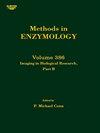E3连接酶FEM1C的荧光极化结合试验。
4区 生物学
Q3 Biochemistry, Genetics and Molecular Biology
引用次数: 0
摘要
Feminization-1同源物C (FEM1C)是Cullin 2-RING E3泛素连接酶(CRL2)的底物识别成分,选择性地结合含有精氨酸末端基元的C-degron,介导靶蛋白的蛋白酶体降解。由于其广泛表达,FEM1C有望用于靶向蛋白降解。本章描述了基于荧光偏振的FEM1C结合实验,以及所需试剂的制备,包括重组蛋白和荧光探针。这些方法可用于鉴定FEM1C的配体或适用于其他E3连接酶,促进了靶向蛋白降解新手柄的开发。本文章由计算机程序翻译,如有差异,请以英文原文为准。
Fluorescence polarization binding assays for the E3 ligase FEM1C.
Feminization-1 homolog C (FEM1C) is a substrate-recognition component of the Cullin 2-RING E3 ubiquitin ligases (CRL2), selectively binding the C-degron containing arginine-terminated motifs to mediate proteasomal degradation of target proteins. Owing to its wide expression, FEM1C holds promise for targeted protein degradation. This chapter describes fluorescence polarization-based binding assays for FEM1C, as well as preparation of the required reagents including the recombinant protein and fluorescent probe. These methods can be applied to identify ligands for FEM1C or adapted for other E3 ligases, facilitating the development of new handles for targeted protein degradation.
求助全文
通过发布文献求助,成功后即可免费获取论文全文。
去求助
来源期刊

Methods in enzymology
生物-生化研究方法
CiteScore
2.90
自引率
0.00%
发文量
308
审稿时长
3-6 weeks
期刊介绍:
The critically acclaimed laboratory standard for almost 50 years, Methods in Enzymology is one of the most highly respected publications in the field of biochemistry. Each volume is eagerly awaited, frequently consulted, and praised by researchers and reviewers alike. Now with over 500 volumes the series contains much material still relevant today and is truly an essential publication for researchers in all fields of life sciences, including microbiology, biochemistry, cancer research and genetics-just to name a few. Five of the 2013 Nobel Laureates have edited or contributed to volumes of MIE.
 求助内容:
求助内容: 应助结果提醒方式:
应助结果提醒方式:


